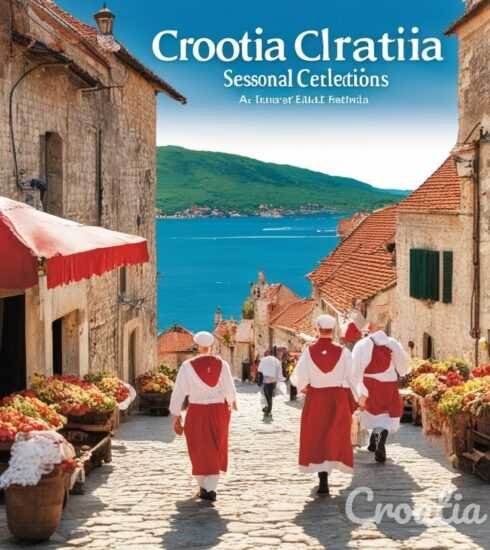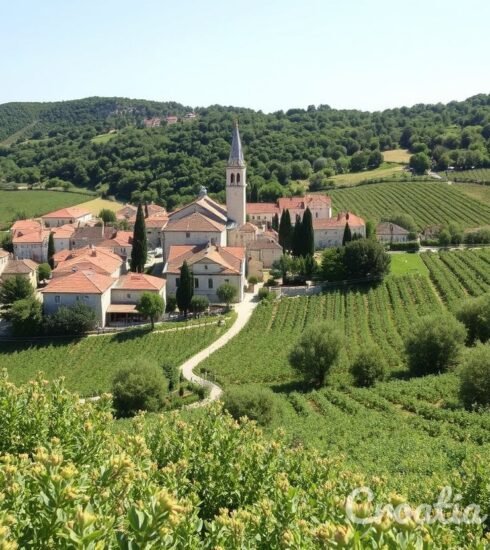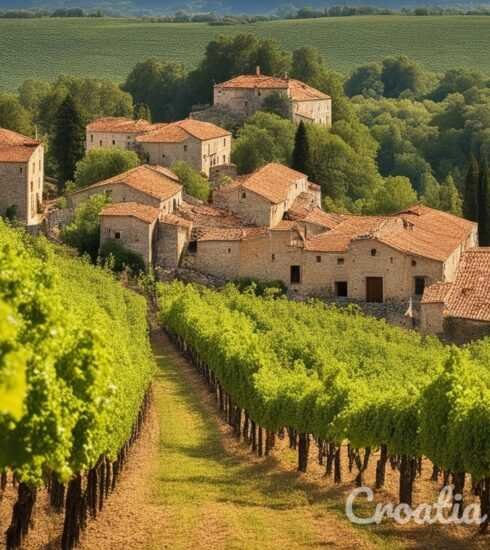Uncover Croatias Enchanting Seasonal Tapestry: Discovering the Secrets of Festive Traditions | Article
Delving into Croatia’s Seasonal Tapestry: Exploring the Unseen Charms of Festive Traditions
Croatia, with its rich cultural heritage and breathtaking natural beauty, is a country that truly comes alive during its vibrant festivals and seasonal celebrations. From ancient traditions to modern festivities, the Croatian people hold a deep appreciation for their cultural heritage, and this is beautifully showcased in the various festivals that take place throughout the year. In this article, we will delve into the unseen charms of Croatian festivals, exploring the unique traditions and customs that make them truly unforgettable.The Kaleidoscope of Croatian Festivals
Croatian festivals offer a kaleidoscope of experiences that reflect the country’s diverse history and regional differences. From religious processions to lively music and dance performances, each festival has its own distinct character and significance. Here are some of the most notable festivals in Croatia:# 1. Dubrovnik Summer Festival
The Dubrovnik Summer Festival is one of the oldest and most prestigious cultural events in Croatia. Held annually from July to August, this festival transforms the historic city of Dubrovnik into a hub of artistic performances. Theater plays, classical music concerts, and dance performances take place in various breathtaking locations, such as the Rector’s Palace and the open-air theater in Lovrijenac Fortress. The festival attracts both local and international artists, making it a true celebration of the arts.
For more information about the Dubrovnik Summer Festival, you can visit the following Croatia Trip article.# 2. Split Summer Festival
The Split Summer Festival, held annually from mid-July to mid-August, is another cultural highlight in Croatia. This festival brings together artists from all over the world to showcase their talents in music, theater, and dance. The performances take place in the Roman-era Diocletian’s Palace, as well as various other locations in Split, creating a unique fusion of ancient and modern art.# 3. Šibenik International Children’s Festival
The Šibenik International Children’s Festival, founded in 1958, is the oldest children’s festival in Croatia and one of the oldest in Europe. This festival aims to nurture the creative spirit of children through various artistic workshops, performances, and exhibitions. The highlight of the festival is the Parade of the Šibenik Children’s Kingdom, where children create their own imaginative costumes and parade through the streets of Šibenik.# 4. Rijeka Carnival
The Rijeka Carnival, held in the coastal city of Rijeka, is the largest and most extravagant carnival in Croatia. This colorful event attracts thousands of visitors from all over the world who come to witness the spectacular costumes, lively music, and energetic dance performances. The Rijeka Carnival is known for its satirical floats and humorous sketches that make fun of current political and social issues.# 5. Varaždin Baroque Evenings
The Varaždin Baroque Evenings, held annually in September, bring the charm of the Baroque period to life. This festival showcases the rich historical and cultural heritage of the city of Varaždin through classical music concerts, theatrical performances, and art exhibitions. With its picturesque streets and well-preserved Baroque architecture, Varaždin provides the perfect backdrop for this elegant festival.# 6. Pula Film Festival
The Pula Film Festival, held in the ancient Roman amphitheater in Pula, is the oldest Croatian film festival and one of the oldest in Europe. This six-day event celebrates Croatian and international cinema, showcasing a wide range of films from various genres. The festival also includes workshops, panel discussions, and awards ceremonies, creating a platform for both established and emerging filmmakers to connect and showcase their work.# 7. St. Blaise Festival in Dubrovnik
The St. Blaise Festival, held annually on February 3rd in Dubrovnik, is a religious celebration dedicated to the city’s patron saint. The festival begins with a procession led by the Dubrovnik Symphony Orchestra and the City Guard, followed by a series of religious ceremonies and traditional performances. The highlight of the festival is the release of white doves from the top of the Dubrovnik Cathedral, symbolizing peace and unity.# 8. Samobor Carnival
The Samobor Carnival, held in the picturesque town of Samobor near Zagreb, is another lively carnival event in Croatia. This festival combines folklore and modern entertainment, with colorful costumes, traditional music, and street performances. The Samobor Carnival is known for its humorous and satirical floats, as well as its delicious traditional food and drink offerings.The Regional Significance of Croatian Festivals
Croatia’s diverse geographical and cultural landscape is reflected in the regional variations of its festivals. Each region has its own unique traditions and customs, adding to the rich tapestry of Croatian festivals. Here are some examples of regional festivals in Croatia:# 1. Zvončari Carnival in Kastav

# 2. Sinjska Alka in Sinj
The Sinjska Alka, held in the town of Sinj in the Dalmatian hinterland, is a medieval knight tournament that has been recognized as a UNESCO Intangible Cultural Heritage of Humanity. Participants, known as alkars, ride on horseback and try to hit a small iron ring with a spear. The tournament symbolizes the historic defense of Sinj against the Ottoman Empire and showcases the equestrian skills and bravery of the participants.
To learn more about the Sinjska Alka, you can read the article available at Croatia Trip.# 3. Đakovački Vezovi in Đakovo
The Đakovački Vezovi, held in the town of Đakovo in Slavonia, is a traditional folklore festival that celebrates the cultural heritage of the region. Participants dress in traditional costumes and perform traditional dances and songs, showcasing the rich folklore and customs of Slavonia. The festival also includes equestrian shows, agricultural exhibitions, and traditional craft demonstrations.# 4. Starigrad Paklenica Rock Climbing Festival
The Starigrad Paklenica Rock Climbing Festival, held in the Paklenica National Park, is a gathering of rock climbing enthusiasts from all over the world. This festival offers a unique opportunity to explore the stunning natural landscapes of the national park and engage in various climbing activities. The festival includes climbing competitions, workshops, and guided climbing tours, catering to both experienced climbers and beginners.A Delight for the Senses: The Food and Drink of Croatian Festivals
In addition to their cultural and artistic offerings, Croatian festivals are also a delight for the senses when it comes to food and drink. Each region in Croatia has its own traditional dishes and culinary specialties, which are showcased during festivals. Here are some mouth-watering examples:# 1. Pag Cheese at the Pag Carnival
The Pag Carnival, held on the island of Pag, is known for its delicious food offerings, including the world-famous Pag cheese. This sheep’s milk cheese has a distinct flavor that is enhanced by the salty winds that sweep across the island. During the carnival, visitors can sample various cheese dishes, such as Pag cheese-filled pastries and grilled cheese served with homemade jam.# 2. Rožata at the Dubrovnik Summer Festival
Rožata, a traditional Dubrovnik dessert, is a must-try during the Dubrovnik Summer Festival. This creamy and caramel-flavored custard is usually served chilled and garnished with caramel sauce. The dessert is believed to have originated from the Dubrovnik Republic’s trade with Venice, and it has become a symbol of the city’s culinary heritage.# 3. Fritule at the Rijeka Carnival
Fritule, small deep-fried pastries, are a staple at the Rijeka Carnival. These fluffy treats are often flavored with citrus zest, brandy, and a hint of rum. Fritule are traditionally served dusted with powdered sugar and can be enjoyed alongside other carnival delicacies, such as krafne (Croatian doughnuts) and kroštule (twisted fried pastries).# 4. Štrukli at the Varaždin Baroque Evenings
Štrukli, a traditional dish from the region of Zagorje, is a highlight of the Varaždin Baroque Evenings. These rolled dumplings are filled with cottage cheese and often served baked with a creamy sauce. Štrukli can be enjoyed as a savory or sweet dish, making them a versatile and delicious treat.Exploring the Unseen Charms of Croatian Festivals
Croatian festivals offer a unique opportunity to delve into the country’s rich cultural heritage and explore its unseen charms. Whether you are a lover of art, music, food, or history, there is a festival in Croatia that will captivate your senses and leave you with unforgettable memories. From ancient traditions to contemporary celebrations, Croatian festivals provide a window into the soul of this vibrant country and the warmth of its people.
If you’re interested in learning more about Croatian festivals, you can visit the following Croatia Trip. Here you will find comprehensive information about the different festivals and events that take place throughout the year in Croatia.So, whether you’re planning your next trip to Croatia or simply want to immerse yourself in the country’s rich cultural heritage, be sure to experience the magic of Croatian festivals and uncover the unseen charms that make them truly special.






